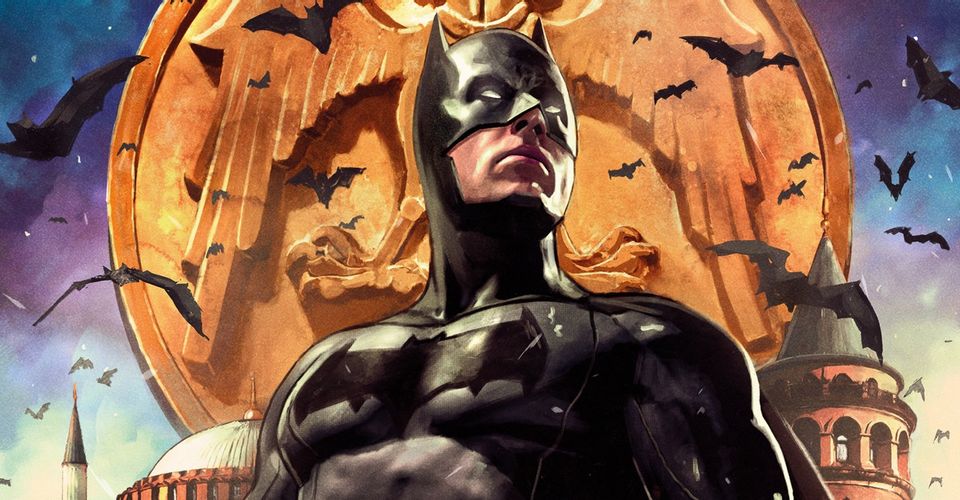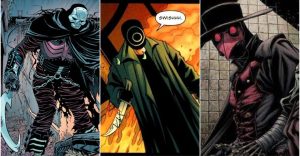Interview: ‘Batman: The World’ Takes The Dark Knight Beyond Gotham

The famous caped crusader may have been born in a darkened alley of Gotham City, but the years since have turned Batman into one of Earth’s mightiest heroes. And to celebrate the global spread of Batman’s adoration, Batman: The World has recruited writers and artists from countries around the world to show what Batman means to them, their nations, and their culture.
Released around the world on September 14, the special issue features some of the most esteemed talent from the United States, France, Brazil, China, and more (with stories and artwork as diverse and outstanding as fans would hope). The collection of stories is just another way DC Comics is celebrating Batman Day on September 18, 2021. And to hear about the creation of the anthology, and the stories drawn from around the globe, Screen Rant was one of a handful of outlets to speak with DC Senior Editor Katie Kubert and writer Brian Azzarello, who has once again teamed with artist Lee Bermejo for a tale taking Batman beyond Gotham. Readers can enjoy the full interview, as well as a selection of preview pages, embedded below.
The first details of this book promised stories that would be unique to each region and each culture. Can you elaborate on the different stories that’s led to?
Katie Kubert: Batman: The World is one of our very first attempts to create stories for a global market. And what that means is tapping the very best from all of these different countries around the world to tell their version of a Batman story. And it’s more than ‘Batman in Gotham City.’ We wanted these stories to feel authentic to both the creators who make them as well as the people from these countries who will be reading them.
So if you look at the story in France, Mathieu Gabella and Thierry Martin, they created a story with Batman and Catwoman in the Louvre. In our Spain story, Paco Roca wrote a story about Bruce Wayne and what it means to take a vacation in Spain. And so each of these stories shows what Batman is doing and what a Batman story would be like, if it took place in say South Korea, or what Batman means to the people of Russia. So it’s really more about the authenticity of the story, and Batman as a global hero, he’s not just the hero for Gotham City, he’s not just someone that people look up to, or someone who sets the ideals for what a hero is in Gotham City or in the United States. It’s really about Batman as a hero for everyone on the entire planet.

Were there any communication barriers to overcome, working with so many different people around the world?
KK: No, there were no communication barriers whatsoever, which is really a feat in itself. Our manager for global publishing partnerships, Bartek Jelonek, he is the one who usually creates business partnerships with our publishers from around the world. He was the one who was kind of like our liaison between the creators and the publishers from the other territories, and the editorial staff here in the U.S.. So Bartek was really just kind of the grease for the wheels. If there was a question, he would help us with whatever country, or if a aprticular talent had a question… And then we did the regular thing that we do with all of our comics, when layouts come in, we compare them against the script, make sure that there were no language barriers and how something was drawn, or how something was interpreted. So it was a surprisingly smooth process, which I’m very, very grateful for with such a large undertaking.
How long has Batman: The World actually been in production?
KK: This book is a very large undertaking, which we were happy to take on. The thing I’m really proud of with the Global Publishing Innovations Group, is that we never say no to anything. We try to do new stuff. So looking into new markets, new formats, that’s really what we’re trying to do. So with this project, it’s never really been done before for DC. We’ve never had a book release globally day and date, the same time with this level of international talent. It was really a challenge for us that we were really excited about. So it has been in the works for a while, I want to say at least about a year, if not more. But yes, it’s something that takes a while, but the results were ultimately worth it.
What were the challenges in curating the book?
KK: The challenges with this book, as with any large anthology book is just the sheer number of pages, and making sure that everything is drawn the way it should be, making sure Batman holds to his core. Making sure that in all of these countries, a lot of times these creators are writing a Batman story or drawing a Batman story for the first time. And so it’s that level of allowing creators to be who they want to be, and tell the story that they want to tell. But making sure that it’s still a Batman story, and making sure Batman would act a certain way.
Making sure, if we introduce new characters or new costumes as we do in the South Korea story, I think, and just making sure that he’s the way he’s supposed to be. So that’s honestly like the biggest challenges at the start of it, making sure that we’re telling the absolute best stories that we can, and that the art is representative of those stories, and really elevating them in a way that we hope we do for all of our comics. So that was a big challenge.
The challenge, of course, is also juggling 14 different territories, 14 different storytelling teams, making sure everybody gets their things in on time making sure the files are right, making sure the translations are correct. So that’s mainly just the normal juggling process of an editor, to begin with.

Will any of these stories affect any current stories going on with Batman?
KK: So with the Batman: The World anthology, we are aiming to tell stories that are more evergreen. So we want stories that, if you’ve never read a Batman story, regardless of what country you live in, regardless of where you’re from, we wanted these to be able to be easily accessible to all readers. So while we do introduce some new heroes and new characters, like Panda Girl in the China story, there are a couple of other villains in the Turkey story that connect to the Court of Owls.
So we like laying the groundwork and like laying seeds that people can pick up. I wouldn’t say never, I’m saying I’m hoping that we can expand them, but no plans right now. The whole reason you introduce new characters is, “Oh there’s this cool character here, maybe I can put them in another story..” But a lot of that is going to be down to the DC writers, the DC Editors… if they find something they want to incorporate into one of their stories. It’s by no means, “I created this and am going to shove it into your story,” no. It’s mainly creating accessible stories and new characters that people hopefully connect with. And hopefully those characters find life elsewhere.
I’ve recently interviewed folks who have curated anthologies, and they liken it to creating a mixtape. Are you working on the order of the titles to the last second, or is the order preset due to the international angle?
KK: Well, publishing… I don’t like to say we go to the last second, but a lot of the times we do. But with the order of the stories for this, it was mainly just dictated by page layout. Because with the story from Japan, you’ve got the Batman unchained story by Okadaya Yuichi, and they wrote the story in traditional manga style. So it reads from right to left, instead of left to right. So that story, of course, had to go at the end. And then it’s just kind of playing with your page count, your layouts, seeing what double-page spreads you have, and just kind of creating it from there. Other than that, yeah, making a mixtape is a very good analogy for this.
Following Batman: The World, will we be seeing DC work even further in the international market?
KK: Oh my god, yes, absolutely! So Global Publishing Innovation is focused on innovating publishing on a global scale. So this is definitely not the last you will be seeing from our team, or with this high achievement level, I would say. Because we want to do more like this, but we want to level up, we want to see what else we can do and like, make things even better. This is definitely us just kind of starting with that. You had Batman/Fortnite: Zero Point was also a global day and date release. But we absolutely want to expand working with international talent, seeing how we can release things, day and date globally. This is definitely not the last of these projects. We’re hoping to expand this in the future.

For Brian Azzarello, what made you want to return to Batman for this story in particular?
Brian Azzarello: I guess it was the global aspect of it. Because both Lee [Bermejo] and I were pretty much done with Batman at that point. But when we got the call about it, I said yes right away. I mean, a lot of the publishers represented in this book, I know personally from traveling, so it was like, “Oh, my God, this would be great. This would be really fun to do something like this.”
Why do you think it’s important for DC and the comic industry, in general, to continue to explore the international market?
KK: Well, you know, DC doesn’t just create stories for American audiences. We don’t just create heroes for American audiences, we have audiences on a global basis. So we want to aim to make more comics, more content, more stories that our international readers can identify with, and can really feel like they see themselves on the page as well as our American audience. It’s something that, I’ve said this a million times, but we want to be authentic. We want these stories to feel authentic.
If we were to have American writers write a Chinese story, it would be great, but it doesn’t have that connectivity. Xu Xiaodong and Lu Xiaotong were the writers for the China story, specifically. It shows particular landscapes, particular statues. Or even the Mexico story, we had certain urban legends and things that American creators might not know or might not be aware of, or it wouldn’t have that level of authenticity to it that we really want with these global stories.
BA: I think that’s what really works in this anthology, is that it’s Batman, who’s pretty much a universal character. You can graft different sorts of cultures onto him. And it was really interesting to see the way that was going down. It was more about not so much the locations for me, as it was the attitudes, and just sort of the culture behind the character and his decisions was different. A little bit different.
KK: As you set that up perfectly in your story as well, Batman is, from a story point, he’s needed around the world. You did a wonderful job.

If you were to do a second volume, are there any countries on your wish list that didn’t make it into the first volume that you’d like to add?
KK: Oh, that’s a tough one. I’m just I’m so pleased with the countries that we were able to get but there are so many others that would have stories to tell.
BA: There was somebody on the social media that was complaining there was no Canadian story.
KK: Canadian is good. I’d like to see an Indian story. Honestly. I’d like to see a story from Thailand. It’s funny when I answer that question, I keep thinking I’m like, “Where do I want to go? And what food do I want to eat?”
BA: Argentina too, that’s a country with a really rich comic tradition.
KK: The Argentinian artists are fantastic. That would be cool to see. I don’t think we had England in here, that would be amazing. Or Ireland, we have so many creators from those territories that are just stellar, and highlighting those stories would be wonderful too.
Did you approach this story differently than other Batman stories knowing that this would reach such a wide audience?
BA: Yes, totally. I thought, well, Lee and I were discussing what we were going to do. And I had, like, a real broad idea about how the world is a macrocosm of Gotham City. There’s crime, corruption everywhere. Listen, he doesn’t just stay in Gotham city, he’s in the Justice League, they go to space, whatever. Let’s do more of what he thinks of the world. And then let’s make it eye candy. Let’s just make it big in big, splashy pages, double-page things, just like something really bold. So that was a difference when we were structuring the story, and then it was a monologue. There’s one narrator, it’s Bruce, but it reads, Lee says it reads like a poem. And I’m like, I don’t know about that. But it looks poetic.
KK: One of the things I really liked, this is one of the ways to show how amazing you and Lee are storytellers. Most of the story is told in double-page spreads. That might not be something that you immediately register, but subconsciously, that makes it feel even larger.

What have you learned about the international market?
BA: I don’t know what I’ve learned through this project, other than it’s bigger than I thought it was.
KK: This project has really helped me as an editor, because, I tried to never be so arrogant to think that I know everything. Especially as an editor for Global Publishing Innovation is constantly about learning and learning not only what each international market’s readers want, but learning what stories the creators from these territories want to tell.
I could not have guessed that the story from Russia, from Kirill and Natalia would have been about how much Batman means to this character in the story growing up. I couldn’t have predicted that that was the story that they wanted to tell. And with the Czech Republic, that story touches on a lot of stuff from the iron curtain, and the problems with socialism, and things like that. So it’s almost a history lesson for me, because then I get to learn like, “Oh there’s this urban legend of this ghost in Mexico, and we want to put that in the story, I had no idea about that.”
Or again, going back to the Czech Republic like learning about the actual Bolshevik sorcerers, and learning that they were actually trying to develop the weapons that you see in the story. And we fictionalized that and show what would happen if they really succeeded. So a lot of this has been learning about each territory, and about what stories matter to them.
Why do you think Batman is so universal?
BA: He’s got the coolest costume of anybody. He doesn’t have powers. Artist, they’ll say Batman, is the coolest.
KK: Batman is the coolest.
BA: Eh, Batman’s got some problems.
KK: Of course they all have problems!
BA: No, Bruce has problems. Batman’s pretty cool.
Batman: The World is available now, wherever comic books are physically and digitally sold.
About The Author


















